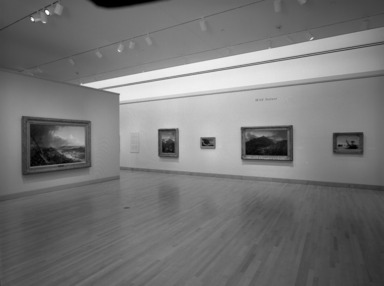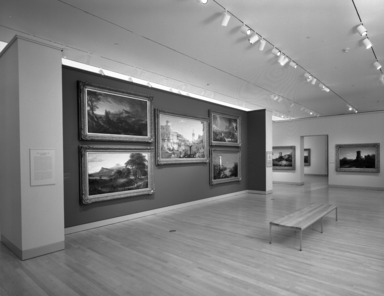

Thomas Cole: Landscape into History, January 13, 1995 through April 2, 1995 (Image: PHO_E1995i051.jpg Brooklyn Museum photograph, 1995)

Thomas Cole: Landscape into History, January 13, 1995 through April 2, 1995 (Image: PHO_E1995i052.jpg Brooklyn Museum photograph, 1995)

Thomas Cole: Landscape into History, January 13, 1995 through April 2, 1995 (Image: PHO_E1995i053.jpg Brooklyn Museum photograph, 1995)
Thomas Cole: Landscape into History
DATES January 13, 1995 through April 2, 1995
ORGANIZING DEPARTMENT
American Art
COLLECTIONS
American Art
-
January 13, 1995
Thomas Cole: Landscape into History, a major retrospective of America’s most important landscape painter of the early 19th century, who is known today as the father of the Hudson River School, will be presented at The Brooklyn Museum from January 13 through April 2, 1995. This exhibition of more than 60 paintings demonstrates Cole’s use of the landscape genre to convey a variety of ideas, all of which reflect his belief in art’s moral purpose as inspired by current English aesthetic theory. Cole’s paintings were at once symbols of the untamed, innocent American character — as represented in his panoramic landscapes of the American Northeast — and comments on the widespread industrialization rapidly transforming these wilderness regions. The exhibition also includes Cole’s Old World and imaginary landscapes, featuring his two most important series of allegorical landscapes: The Course of Empire (1834-36) and The Voyage of Life (1842), brought together for the first time since the artist’s death.
The exhibition was organized by the National Museum of American Art, in cooperation with The New-York Historical Society. The New York venue and programs for the exhibition, a collaboration between The Brooklyn Museum and The New-York Historical Society, have been made possible by the generous support of The Henry Luce Foundation, Inc. Important support has also been provided by the David Schwartz Foundation, Inc.
Born in Lancashire, England, Thomas Cole (1801-1848) arrived in the U.S. at the age of 17. He spent his youth traveling throughout the eastern states, learning what he could of literature and art, and at the same time experiencing the nation poised on the brink of becoming a leading world power. In the spring of 1825, Cole arrived in New York City and, working in the house his father had rented on Greenwich Street, pursued a career as an artist. He completed a number of landscapes of the Hudson Highlands and the Catskill Mountains, several of which were acquired by the artist-writer William Dunlap, the artist Asher B. Durand, and the president of the American Academy of Fine Arts, Colonel John Trumbull, who introduced Cole and his work to a number of future patrons.
Cole’s regional landscape paintings quickly became popular and are significant artistic statements reflecting the larger “landscape culture” expressed through popular prints, travel literature, and travel guides, as well as expeditions to sites renowned for their beautiful or sublime qualities. Though he settled permanently in the town of Catskill, New York, in 1836 and continued to depict Catskill scenery throughout his career, Cole went on to paint views of the Adirondack and White Mountains; of Massachusetts and Maine; and of such European subjects as the Roman Campagna, Mount Etna, and the ancient temples at Paestum. These works, as well as subjects drawn from the Bible and secular literature, will be installed thematically.
Cole’s paintings are widely recognized today as more than simply records of beautiful or dramatic vistas. His panoramic landscapes record the rhythms of nature, evoking parallels with the cyclical forces then believed to drive history and demonstrating how the “progress” of past civilizations was recorded on the Old World landscape. Central to the thesis of the exhibition are Cole’s elaborations upon this potent theme in his masterful allegorical landscapes; a series depicting human fate in The Voyage of Life and five works charting the rise and fall of an entire civilization in The Course of Empire. Cole’s preoccupation in these works with the cyclical theory of history provided a vehicle by which he commented on many of the contested political and social issues of his time, the turbulent era of Jacksonian Democracy.
Thomas Cole: Landscape into History, co-curated by William H. Truettner of the National Museum of American Art and Alan Wallach of the College of William and Mary, was coordinated at The Brooklyn Museum by Linda S. Ferber, Chief Curator. A fully illustrated catalogue accompanies the exhibition. The exhibition was made possible by the generous support of NYNEX Foundation. Preliminary funding was provided by the Smithsonian’s Special Exhibition Fund.
Thomas Cole: Landscape into History, with essays by Christine Stansell and Sean Wilentz, Alan Wallach, J. Gray Sweeney, and William H. Truettner. Truettner and Wallach, eds. 186 pgs. 191 photos, incl. 101 color plates. $29.95 soft cover, $50.00 cloth.
SYMPOSIUM
Thomas Cole: Private Patronage and the Development of Public Collections
Saturday, March 11 10 a.m.-4 p.m.
Admission: $20 for the general public; $10 for Museum members, students, and older adults.
Scholars of American art and culture will present original papers that explore the relationships between private patronage, the growth of public collections, and the evolution of an artistic reputation. The day will conclude with a panel discussion in which all of the symposium participants will discuss future directions for Cole studies.
Participants:
Annette Blaugrund, Andrew Mellon Senior Curator, The New-York Historical Society, New York, New York
“Thomas Cole’s Patrons and Their Association with The New-York Historical Society”
Elizabeth Kornhauser, Curator of American Painting, Wadsworth Atheneum, Hartford, Connecticut
“Daniel Wadsworth and Thomas Cole: From Monte Video to the Willey Disaster”
Elizabeth Milroy, Assistant Professor of Art, Wesleyan University, Wesleyan, Connecticut
“Contested Spaces: The Landscape on Display During the Civil War”
Kenneth Myers, Assistant Professor of American Literature and Civilization, Middlebury College, Middlebury, Connecticut
“Cole and the Economics of Landscape in Jacksonian New York”
Ellwood Parry, Professor of American Art, University of Arizona, Tucson
William H. Truettner, Curator of American Painting and Sculpture, National Museum of American Art, Washington D.C.; co-curator, Thomas Cole: Landscape into History
Alan Wallach, Ralph H. Wark Professor of the Fine Arts, College of William and Mary, Williamsburg, Virginia; co-curator, Thomas Cole: Landscape into History
“Long Term Visions, Short Term Values: Art Institutions in New York City, 1830-1860”
Moderators:
Annette Blaugrund and Linda Ferber, Chief Curator and Curator of American Painting and Sculpture, The Brooklyn Museum
Brooklyn Museum Archives. Records of the Department of Public Information. Press releases, 1995 - 2003. 01-06/1995, 025-8.
View Original -
June 14, 1994
National Museum of American Art; Smithsonian Institution; Washington, DC; Mar. 18-Aug. 7 1994
Wadsworth Atheneum; Hartford, CT; Sept. 11-Dec. 4 1994
The Brooklyn Museum; Brooklyn, NY; Jan. 13-Apr. 2 1995
WASHINGTON, D.C., June 14, 1994—Elizabeth Broun, director of the National Museum of American Art, and Robert T. Buck, director of The Brooklyn Museum, today announced that the special exhibition, “Thomas Cole: Landscape into History,” will be presented at The Brooklyn Museum in collaboration with The New-York Historical Society January 13 through April 2, 1995. The show, which was organized by the National Museum of American Art, is in Washington through August 7.
The decision to place the exhibition with The Brooklyn Museum follows a recent announcement that The New-York Historical Society had withdrawn from the exhibition tour, for which it was to have been the third venue, in order to complete renovations.
Henry Luce III, a trustee of The New-York Historical Society, has stepped forward to provide funding of $200,000 from the Henry Luce Foundation to make this presentation of the exhibition and public programs possible.
The David Schwartz Foundation, whose president, Richard J. Schwartz, is a commissioner of the National Museum of American Art, is also providing significant support of $50,000 for the Brooklyn venue.
“We are delighted that The Brooklyn Museum has offered to host this significant retrospective of one of New York’s most important painters,” Broun said. “The show will be wonderfully complemented by Brooklyn’s superb collection of 19th-century American art.”
Broun added, “We are in the process of contacting the lenders to the exhibition to secure their permissions for this venue, and we anticipate that they will be delighted.”
“It is a pleasure to work with the National Museum of American Art in bringing ‘Thomas Cole: Landscape into History’ to a New York audience,” said Buck. We are enormously grateful to Henry Luce and to the Luce Foundation for stepping in to provide the eleventh-hour support to this collaboration between the museum and the Historical Society for the exhibition and programs, including a symposium.”
With more than 75 paintings on loan from 38 lenders, “Thomas Cole: Landscape into History” is the largest and most ambitious retrospective of the painter’s work since the memorial exhibition in New York City in 1848 following Cole’s death.
Centerpieces of “Thomas Cole: Landscape into History,” co-curated by William Truettner of the National Museum of American Art and Alan Wallach of the College of William and Mary, are Cole’s two important allegorical series, “The Course of Empire,“ on loan for the first time ever from the Historical Society, and “The Voyage of Life,” on loan from the National Gallery of Art.
Before traveling to Brooklyn, the exhibition will be on view, as scheduled, at the Wadsworth Atheneum in Hartford, Connecticut, September 11 through December 4.
“Thomas Cole: Landscape into History” was organized by the National Museum of American Art, in cooperation with The New-York Historical Society, and was made possible by the generous support of NYNEX Foundation. Preliminary funding was provided by the Smithsonian’s Special Exhibition Fund.
Brooklyn Museum Archives. Records of the Department of Public Information. Press releases, 1989 - 1994. 01-06/1994, 070-71.
View Original



